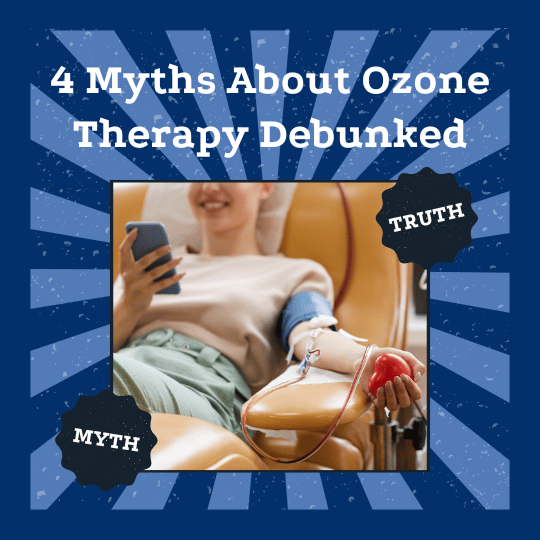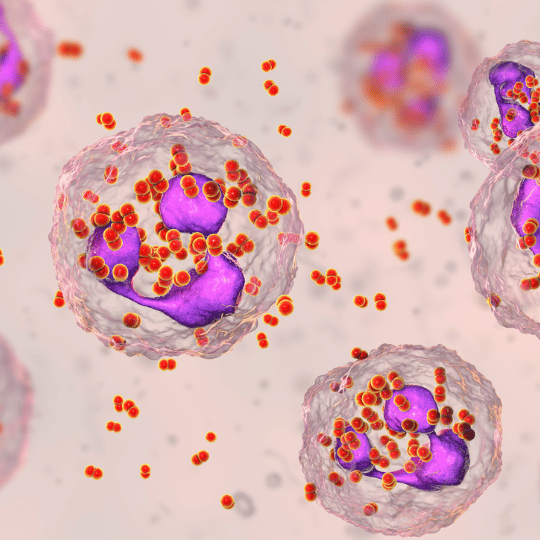Ozone therapy - There are many common myths about ozone therapy. Learn which information is false as well as the surprising facts about this up and coming wellness treatment.
Ozone therapy has gained much attention in recent years for its various health benefits, however there are still many myths and misconceptions surrounding it. In this article we’ll be exploring the 4 most common myths about ozone therapy to help you better understand the facts.
Ozone is not only beneficial for your overall wellbeing but it can also improve conditions like Autoimmune Disease, Multiple Sclerosis, Chronic Fatigue Syndrome, Fibromyalgia and even cancer. So let’s get to debunking these myths!
What is Ozone Therapy?
Ozone therapy is a form of alternative medicine that involves administering ozone gas or ozonated liquids into the body for therapeutic purposes. The ozone can be applied through intravenous infusions, topically, or via ingestion in order to help improve circulation, reduce inflammation and boost your immune system. Ozone therapy is used to help with a wide range of conditions and ailments.
Often confused with oxygen therapy, ozone therapy actually involves the medical application of ozone gas (O3) or activated oxygen to treat a variety of health conditions. The therapy consists of introducing small amounts of ozone into the body, either intravenously, injection, rectal insufflation or through skin contact. Since ozone gas is antibacterial, antiviral, antimicrobial, and antifungal, introducing the gas into the body stimulates the body’s immune system to help fight off bacteria and virus, detoxify the blood, improve circulation and oxygenation.
Myth #1 - Ozone Therapy Is Dangerous
Explaining the benefits of ozone therapy and the safety measures taken by certified practitioners:
Despite what some may believe, ozone therapy is not a dangerous treatment option. In fact, ozone therapy has been used for over 150 years to treat a wide variety of medical conditions. It is a natural and effective therapy that can help improve circulation, boost the immune system, and detoxify the body.
Certified practitioners, like Regen IV Wellness, take strict safety measures to ensure that patients receive the appropriate amount of ozone gas through a medically certified ozone generator machine. The procedure is carefully monitored to ensure that the patient is not exposed to any harmful levels of ozone. Ozone therapy is a safe and effective treatment option that can help individuals promote healing and achieve optimal health.
Myth #2 - Ozone Therapy Is Unregulated
Examining the regulations, standards, and certification requirements for ozone therapy practitioners:
Ozone therapy, a complementary medical treatment that uses ozone gas to promote healing and manage various health conditions, has been a subject of controversy and scrutiny over the years. One common myth about ozone therapy is that it is unregulated, leading many to worry about the safety and efficacy of the treatment.
However, a closer look at the regulations, standards, and certification requirements for ozone therapy practitioners reveals a different picture. In fact, many countries including the United States, Germany, Canada, and Australia have specific guidelines and standards in place for ozone practitioners, as well as professional organizations that offer certification and training programs. By examining the regulations and requirements for ozone therapy, patients can make informed decisions and choose qualified practitioners who adhere to the highest standards of safety and efficacy.
Myth #3 - Ozone Therapy Is Only Effective for Treating Infections
Exploring other potential uses for ozone therapy, such as pain relief, reducing inflammation, and improving cardiovascular health:
While ozone therapy is most commonly associated with treating infections, there are other potential uses for this form of treatment. Studies have shown that it can be effective in reducing pain and inflammation, making it a promising therapy for individuals suffering from chronic pain or joint issues. Additionally, ozone therapy has been shown to have a positive impact on cardiovascular health, potentially reducing the risk of heart disease and stroke.
While more research is needed to fully understand the extent of its benefits, these promising applications highlight the potential of ozone therapy beyond its traditional uses. As the medical community continues to explore this therapy, it may become increasingly incorporated into treatment plans for a range of conditions.
Myth #4 - Ozone Therapy is Not Supported by Research
Presenting research studies supporting the efficacy of ozone therapy:
Ozone therapy has long been a controversial topic in the medical world, with many skeptics questioning its efficacy. However, a growing body of research studies has shed light on the benefits of this treatment option. One study published in the Journal of Natural Science, Biology, and Medicine found that ozone therapy was highly effective in treating chronic lower back pain. Another study, published in the International Journal of Cancer Research and Treatment, demonstrated that ozone therapy was effective in reducing tumor size in patients with pancreatic cancer.
These studies provide strong evidence to support the use of ozone therapy in various medical applications. While more research is needed to fully understand the potential of this therapy, these findings are certainly promising for those seeking alternative treatment options.
The Bottom Line About Ozone Therapy
Summarizing key points and addressing common misconceptions about ozone therapy to provide an unbiased overview of Ozone Therapy benefits:
Ozone therapy is a topic that has received significant attention in recent years as an alternative form of healthcare treatment. This therapy involves administering ozone gas into the body to boost the immune system, improve circulation, and reduce inflammation, amongst other benefits. However, there are some common misconceptions surrounding ozone therapy that need to be addressed. For instance, some believe that the therapy is harmful and can lead to negative side effects.
However, with the right precautions and proper guidance from a licensed practitioner, ozone therapy is considered safe and effective. By summarizing key points and separating facts from fiction, readers are better able to understand the benefits of ozone therapy and make informed decisions about their health.
Ozone therapy is a powerful, safe treatment option that has been supported by increasing research evidence.
It can be used as supportive treatment to treat and prevent infection, reduce inflammation, relieve pain, and improve cardiovascular health. Certification is required for all practitioners and strict regulations are in place to protect the safety of patients. Although there are still some misconceptions about ozone therapy that prevent people from seeking its potential benefits, this blog post has debunked those myths and provided readers with an unbiased overview of its efficacy.
The bottom line is that ozone therapy is safe, regulated, multifaceted—and potentially life changing for many individuals. With extensive practice guidelines and positive research findings now available , it’s time to acknowledge the power of this innovative treatment modality – so everyone can take advantage of it. If you’re ready to learn more about how Ozone Therapy can help you on your healing journey, schedule a free consult with one of our certified practitioners.






